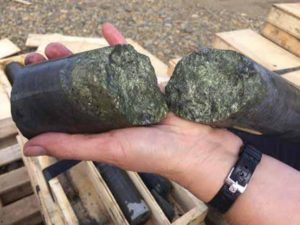
Diamond drill core from the Freegold Ventures Shorty Creek Project in Alaska. Note the massive chalcopyrite (copper) mineralization. Photo courtesy Freegold Ventures Ltd
The most exciting news from a mining exploration stock is a high-grade drilling result. But what constitutes a good assay? It varies from situation to situation and commodity to commodity. Listed below is some rule of thumb information on interpreting drill results for investors.
The first thing investors must under-stand is that high-grade mineralization is relative to the depth of the intersection and relative to the size of the intersection. Today’s mining technology allows mining on a vast scale, with large open pits and huge 200-tonne mining trucks capable of processing large volumes of ore at a low cost. This is possible, provided the zone is near surface and the ore zone is large enough to be mined in bulk. Open pits are generally less than 300 metres deep and are several hundred metres in diameter. Two questions to ask are:
• Is the zone less than 300 metres deep?
• Is the drill intercept over 100 metres thick?
If both of these questions can be answered ‘yes’, then the threshold for what constitutes ‘high-grade’ will be dramatically lower. As a rule of thumb, open pit mining can process ore for $10 per tonne and, where the ore grade is more than double that at $20 per tonne, results would be economic. Consider that 1% of a metric tonne is 22 pounds. Then, for a commodity worth about $1 per pound such as zinc, 1% zinc worth $22 per tonne becomes interesting. Grades triple that, worth $66 per tonne when less than 300 metres deep and more than 100 metres thick, would be considered high-grade.
Using the same dollar figures for mining, but considering other commodities, here are some high-grade intercepts for other commodities and a few recent examples.
COPPER: Anything over 100 metres and 1% copper equivalent or better is considered to be high-grade. For example, Serengeti Resources announced 119.6 metres of 0.9% copper equivalent (copper plus gold values added together) at depths from 180 to 300 metres. The stock then increased from $0.30 to $1.50 after those drilling results were reported.
NICKEL: This valuable metal doesn’t usually occur in nature as a bulk tonnage target since most bulk tonnage mines contain 100 million tonnes of ore or more, and most hard rock nickel deposits are less than 10 million tonnes in size. Therefore, anything over 20 metres in thickness (significantly less thickness than other commodities) and 2% nickel grade or better would be reasonably considered high-grade. Example: In September 2007, Noront Resources released two nickel intercepts from shallow drilling between 80 metres and 150 metres deep, with a section of 71 metres grading 1.8% nickel and 1.5% copper. The stock moved from $0.80 to $4.00.
GOLD: It is usually reported in grams per tonne (or g/t), although sometimes, in the US, it is in oz/ton. A gram of gold is worth about $25, so 2 grams or better would be viewed as high-grade for bulk tonnage mining. One hundred metres of good grade is again good criteria for thickness.
As a spectacular example, Aurelian Resources announced intercepts of 216 metres grading 12.8 grams gold/tonne from its Fruta Del Norte deposit in Ecuador, now owned by Lundin Gold. This result is truly exceptional in terms of grade and thickness, and propelled the stock from $2 to over $22 in 2006. However, this extreme grade and thickness only comes along once every 10 years or so.
URANIUM: Uranium has traded in a wide range over the last 10 years, being negatively impacted by the shutdown of the nuclear industry in Japan. It is sold under long term contracts with undisclosed prices so it is difficult to know a reliable reference price. I would use $50 per pound as a long term price and suggest that an open pit target that grades 2.2 pounds/tonne, or approximately 0.1% would be an economic intercept over 100 metres. For high-grade, underground deposits, a grade of 1% would be a significant intercept over thicknesses of 2 metres or more.
DIAMONDS: Economic diamond mines are generally small even though they are commonly shallow deposits mined by open pits. The contained value per tonne can be extremely high, but varies from deposit to deposit, depending on the quality and size distribution of the contained diamonds. Larger diamonds are much more valuable than smaller ones, and consequently, two diamond deposits with the same grade, which contain different proportions of large stones, will vary significantly in their value per tonne of ore.